IMS sip呼叫流程
- 格式:pdf
- 大小:458.86 KB
- 文档页数:40
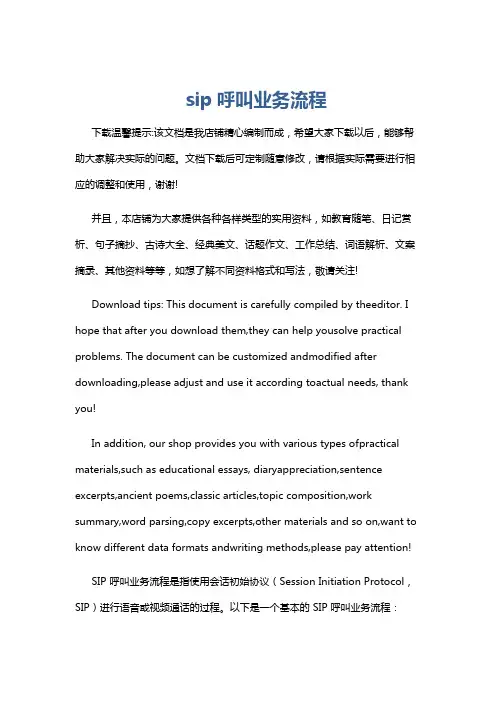
sip呼叫业务流程下载温馨提示:该文档是我店铺精心编制而成,希望大家下载以后,能够帮助大家解决实际的问题。
文档下载后可定制随意修改,请根据实际需要进行相应的调整和使用,谢谢!并且,本店铺为大家提供各种各样类型的实用资料,如教育随笔、日记赏析、句子摘抄、古诗大全、经典美文、话题作文、工作总结、词语解析、文案摘录、其他资料等等,如想了解不同资料格式和写法,敬请关注!Download tips: This document is carefully compiled by theeditor. I hope that after you download them,they can help yousolve practical problems. The document can be customized andmodified after downloading,please adjust and use it according toactual needs, thank you!In addition, our shop provides you with various types ofpractical materials,such as educational essays, diaryappreciation,sentence excerpts,ancient poems,classic articles,topic composition,work summary,word parsing,copy excerpts,other materials and so on,want to know different data formats andwriting methods,please pay attention!SIP 呼叫业务流程是指使用会话初始协议(Session Initiation Protocol,SIP)进行语音或视频通话的过程。
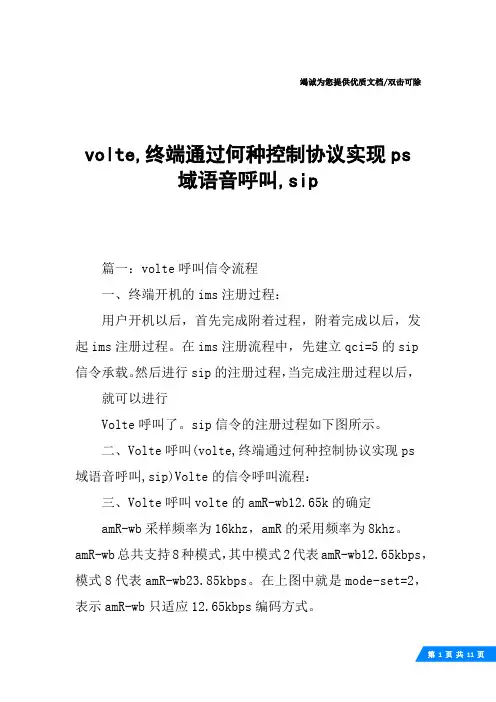
竭诚为您提供优质文档/双击可除volte,终端通过何种控制协议实现ps域语音呼叫,sip篇一:volte呼叫信令流程一、终端开机的ims注册过程:用户开机以后,首先完成附着过程,附着完成以后,发起ims注册过程。
在ims注册流程中,先建立qci=5的sip信令承载。
然后进行sip的注册过程,当完成注册过程以后,就可以进行Volte呼叫了。
sip信令的注册过程如下图所示。
二、Volte呼叫(volte,终端通过何种控制协议实现ps域语音呼叫,sip)Volte的信令呼叫流程:三、Volte呼叫volte的amR-wb12.65k的确定amR-wb采样频率为16khz,amR的采用频率为8khz。
amR-wb总共支持8种模式,其中模式2代表amR-wb12.65kbps,模式8代表amR-wb23.85kbps。
在上图中就是mode-set=2,表示amR-wb只适应12.65kbps编码方式。
Volte呼叫过程中,inVite消息中携带的媒体类型和编码格式:主被叫协商以后,在update消息中确定的媒体类型和编码格式:篇二:Volte语音信令流程Volte语音流程语音呼叫流程6个模块:1、invite业务请求2、会话进度上报3、协商sdp4、振铃5、接通6、挂机前台信令:sip信令详析:1、inVite-Request(inVite)用户a发送上行数据,呼叫用户b,首先向as服务器(p-cscF)发送inVite请求,lte系统中会以数据的方式进行传输,用户a发送上行数据到as服务器,其中携带sip 信令inVite请求。
最大跳跃数,就是经过sip服务器的跳跃次数,主要是防止循跳跃,每注册一次,该整数减一。
p-cscF对不同sip消息的处理2、100trying(inVite-trying/inVite100)as服务器发送100trying的确认消息给用户a,确认收到inVite消息.临时响应,表示你的请求已经收到,在处理中;同时转发inVite到用户b,对ueb发起寻呼流程;3、183sessionprogress(invite-sessionprogress/invite183)用户b向as服务器送183sessionprogress消息,提示建立对话的进度信息。
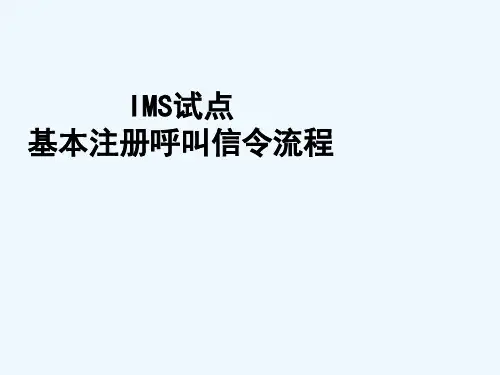
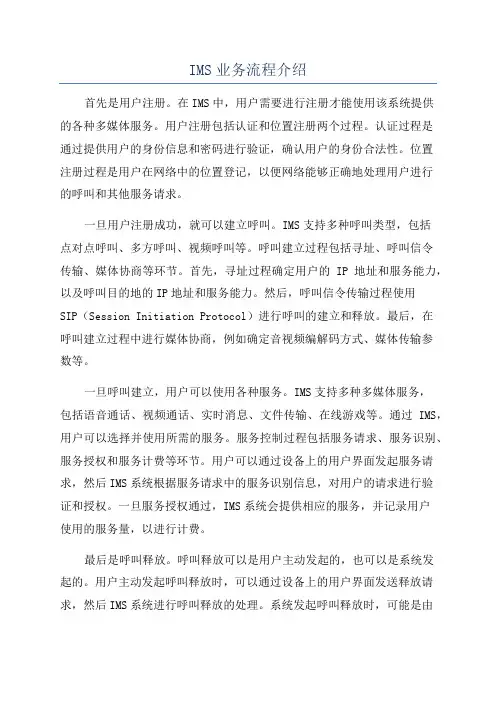
IMS业务流程介绍首先是用户注册。
在IMS中,用户需要进行注册才能使用该系统提供的各种多媒体服务。
用户注册包括认证和位置注册两个过程。
认证过程是通过提供用户的身份信息和密码进行验证,确认用户的身份合法性。
位置注册过程是用户在网络中的位置登记,以便网络能够正确地处理用户进行的呼叫和其他服务请求。
一旦用户注册成功,就可以建立呼叫。
IMS支持多种呼叫类型,包括点对点呼叫、多方呼叫、视频呼叫等。
呼叫建立过程包括寻址、呼叫信令传输、媒体协商等环节。
首先,寻址过程确定用户的IP地址和服务能力,以及呼叫目的地的IP地址和服务能力。
然后,呼叫信令传输过程使用SIP(Session Initiation Protocol)进行呼叫的建立和释放。
最后,在呼叫建立过程中进行媒体协商,例如确定音视频编解码方式、媒体传输参数等。
一旦呼叫建立,用户可以使用各种服务。
IMS支持多种多媒体服务,包括语音通话、视频通话、实时消息、文件传输、在线游戏等。
通过IMS,用户可以选择并使用所需的服务。
服务控制过程包括服务请求、服务识别、服务授权和服务计费等环节。
用户可以通过设备上的用户界面发起服务请求,然后IMS系统根据服务请求中的服务识别信息,对用户的请求进行验证和授权。
一旦服务授权通过,IMS系统会提供相应的服务,并记录用户使用的服务量,以进行计费。
最后是呼叫释放。
呼叫释放可以是用户主动发起的,也可以是系统发起的。
用户主动发起呼叫释放时,可以通过设备上的用户界面发送释放请求,然后IMS系统进行呼叫释放的处理。
系统发起呼叫释放时,可能是由于呼叫过程中发生了错误或异常情况,例如呼叫建立失败、服务控制失败等。
IMS系统会向用户发送释放信令,告知用户呼叫释放的原因。
综上所述,IMS的业务流程包括用户注册、呼叫建立、服务控制和呼叫释放等环节。
用户通过注册来使用IMS提供的多媒体服务,通过呼叫建立来进行通话或其他服务,通过服务控制来验证授权和计费,通过呼叫释放来结束通话。
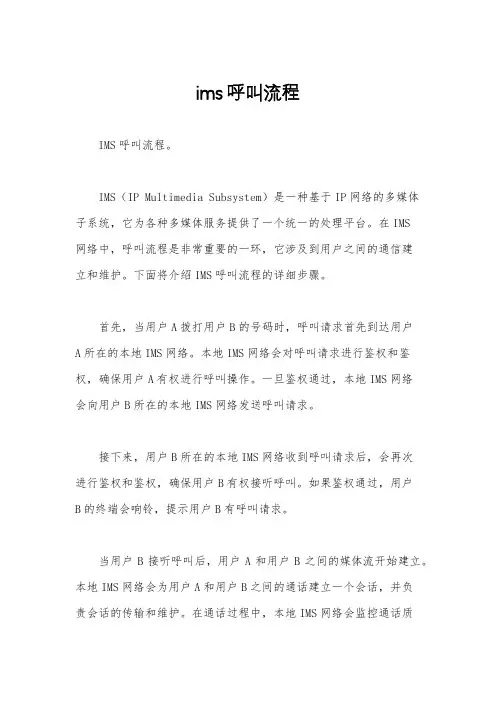
ims呼叫流程IMS呼叫流程。
IMS(IP Multimedia Subsystem)是一种基于IP网络的多媒体子系统,它为各种多媒体服务提供了一个统一的处理平台。
在IMS网络中,呼叫流程是非常重要的一环,它涉及到用户之间的通信建立和维护。
下面将介绍IMS呼叫流程的详细步骤。
首先,当用户A拨打用户B的号码时,呼叫请求首先到达用户A所在的本地IMS网络。
本地IMS网络会对呼叫请求进行鉴权和鉴权,确保用户A有权进行呼叫操作。
一旦鉴权通过,本地IMS网络会向用户B所在的本地IMS网络发送呼叫请求。
接下来,用户B所在的本地IMS网络收到呼叫请求后,会再次进行鉴权和鉴权,确保用户B有权接听呼叫。
如果鉴权通过,用户B的终端会响铃,提示用户B有呼叫请求。
当用户B接听呼叫后,用户A和用户B之间的媒体流开始建立。
本地IMS网络会为用户A和用户B之间的通话建立一个会话,并负责会话的传输和维护。
在通话过程中,本地IMS网络会监控通话质量,确保通话畅通无阻。
最后,在通话结束时,用户A或用户B挂断电话,本地IMS网络会释放会话资源,结束通话。
同时,本地IMS网络会向对方发送挂断消息,通知对方通话已经结束。
总的来说,IMS呼叫流程包括呼叫请求的发起、鉴权和鉴权、呼叫接听、媒体流建立和通话结束等步骤。
通过这些步骤,IMS网络能够实现用户之间的多媒体通信,为用户提供高质量的通话体验。
在实际应用中,IMS呼叫流程还可能涉及到一些特殊情况的处理,比如用户不在线、用户忙线、用户拒接等情况。
针对这些情况,IMS网络会有相应的处理机制,确保呼叫流程能够顺利进行。
总之,IMS呼叫流程是IMS网络中非常重要的一环,它直接影响到用户之间通信的质量和稳定性。
只有对IMS呼叫流程有深入的了解,才能更好地设计和优化IMS网络,为用户提供更好的通信服务。
希望本文对IMS呼叫流程有所帮助,谢谢阅读。
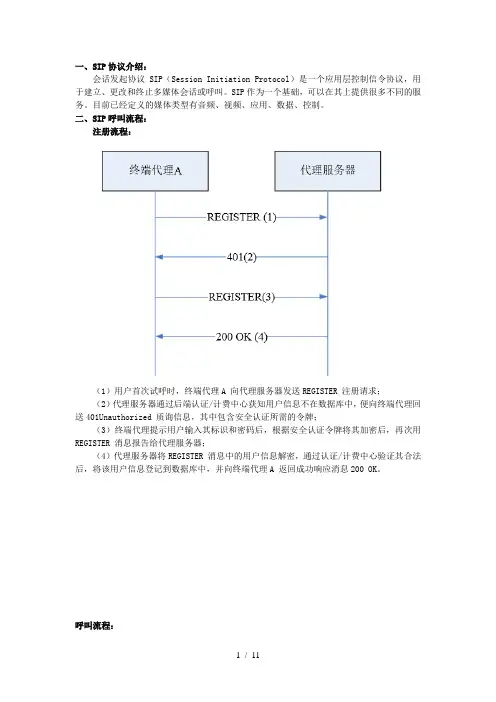
一、SIP协议介绍:会话发起协议SIP(Session Initiation Protocol)是一个应用层控制信令协议,用于建立、更改和终止多媒体会话或呼叫。
SIP作为一个基础,可以在其上提供很多不同的服务。
目前已经定义的媒体类型有音频、视频、应用、数据、控制。
二、SIP呼叫流程:注册流程:(1)用户首次试呼时,终端代理A 向代理服务器发送REGISTER 注册请求;(2)代理服务器通过后端认证/计费中心获知用户信息不在数据库中,便向终端代理回送401Unauthorized 质询信息,其中包含安全认证所需的令牌;(3)终端代理提示用户输入其标识和密码后,根据安全认证令牌将其加密后,再次用REGISTER 消息报告给代理服务器;(4)代理服务器将REGISTER 消息中的用户信息解密,通过认证/计费中心验证其合法后,将该用户信息登记到数据库中,并向终端代理A 返回成功响应消息200 OK。
呼叫流程:(1)用户摘机发起一路呼叫,终端代理A 向该区域的代理服务器发起Invite 请求;(2)代理服务器通过认证/计费中心确认用户认证已通过后,检查请求消息中的Via 头域中是否已包含其地址。
若已包含,说明发生环回,返回指示错误的应答;如果没有问题,代理服务器在请求消息的Via 头域插入自身地址,并向Invite 消息的To 域所指示的被叫终端代理B 转送Invite 请求;(3)代理服务器向终端代理A 送呼叫处理中的应答消息,100 Trying;(4)终端代理B 向代理服务器送呼叫处理中的应答消息,100 Trying;(5)终端代理B 指示被叫用户振铃,用户振铃后,向代理服务器发送180 Ringing 振铃信息;(6)代理服务器向终端代理A 转发被叫用户振铃信息;(7)被叫用户摘机,终端代理B 向代理服务器返回表示连接成功的应答(200 OK);(8)代理服务器向终端代理A 转发该成功指示(200 OK);(9)终端代理A 收到消息后,向代理服务器发ACK 消息进行确认;(10)代理服务器将ACK 确认消息转发给终端代理B;(11)主被叫用户之间建立通信连接,开始通话;结束流程:(2)用户通话结束后,被叫用户挂机,终端代理B 向代理服务器发送Bye 消息;(3)代理服务器转发Bye 消息至终端代理A,同时向认证/计费中心送用户通话的详细信息,请求计费;(4)主叫用户挂机后,终端代理A 向代理服务器发送确认挂断响应消息200 OK;(5)代理服务器转发响应消息200OK;注:RFC3621上结束流程为:终端代理B直接发送Bye至终端代理A(未通过代理服务器转发),测试时使用的X-Lite软件Bye消息目的IP为代理服务器。
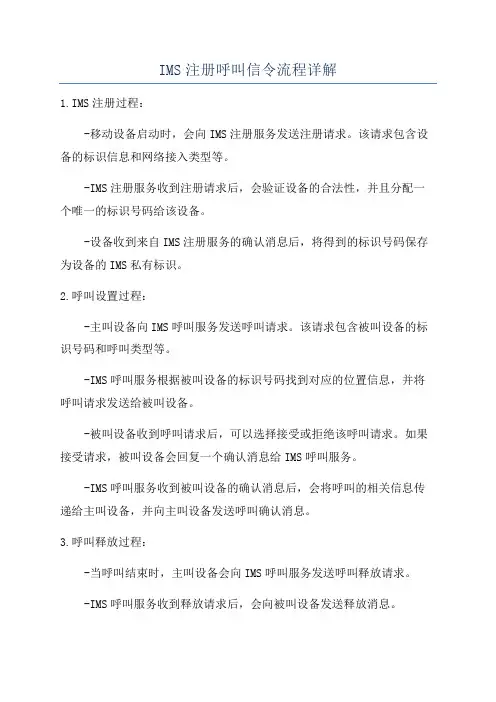
IMS注册呼叫信令流程详解
1.IMS注册过程:
-移动设备启动时,会向IMS注册服务发送注册请求。
该请求包含设备的标识信息和网络接入类型等。
-IMS注册服务收到注册请求后,会验证设备的合法性,并且分配一个唯一的标识号码给该设备。
-设备收到来自IMS注册服务的确认消息后,将得到的标识号码保存为设备的IMS私有标识。
2.呼叫设置过程:
-主叫设备向IMS呼叫服务发送呼叫请求。
该请求包含被叫设备的标识号码和呼叫类型等。
-IMS呼叫服务根据被叫设备的标识号码找到对应的位置信息,并将呼叫请求发送给被叫设备。
-被叫设备收到呼叫请求后,可以选择接受或拒绝该呼叫请求。
如果接受请求,被叫设备会回复一个确认消息给IMS呼叫服务。
-IMS呼叫服务收到被叫设备的确认消息后,会将呼叫的相关信息传递给主叫设备,并向主叫设备发送呼叫确认消息。
3.呼叫释放过程:
-当呼叫结束时,主叫设备会向IMS呼叫服务发送呼叫释放请求。
-IMS呼叫服务收到释放请求后,会向被叫设备发送释放消息。
-被叫设备收到释放消息后,向IMS呼叫服务发送释放确认消息。
-IMS呼叫服务收到释放确认消息后,将呼叫释放的相关信息传递给
主叫设备,并向主叫设备发送释放确认消息。
总结起来,IMS注册呼叫信令流程包括注册过程、呼叫设置过程和呼
叫释放过程。
通过这些过程,移动设备可以在IMS网络上实现多媒体通信,包括语音、视频、短信和数据传输等。
这些信令过程保证了设备之间的顺
畅通信,使人们能够享受高质量的多媒体通信服务。
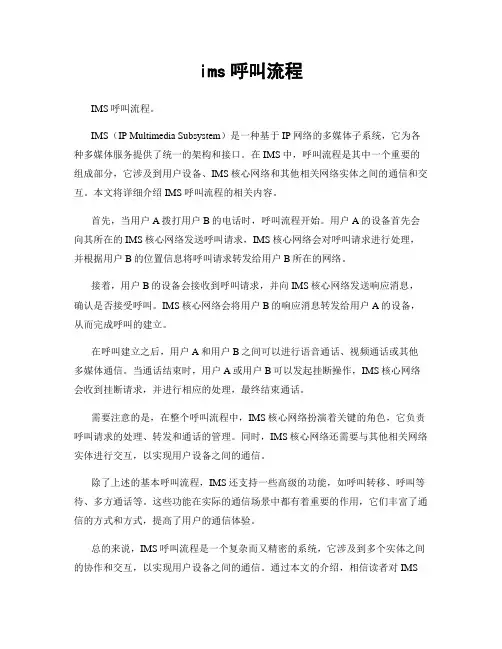
ims呼叫流程IMS呼叫流程。
IMS(IP Multimedia Subsystem)是一种基于IP网络的多媒体子系统,它为各种多媒体服务提供了统一的架构和接口。
在IMS中,呼叫流程是其中一个重要的组成部分,它涉及到用户设备、IMS核心网络和其他相关网络实体之间的通信和交互。
本文将详细介绍IMS呼叫流程的相关内容。
首先,当用户A拨打用户B的电话时,呼叫流程开始。
用户A的设备首先会向其所在的IMS核心网络发送呼叫请求,IMS核心网络会对呼叫请求进行处理,并根据用户B的位置信息将呼叫请求转发给用户B所在的网络。
接着,用户B的设备会接收到呼叫请求,并向IMS核心网络发送响应消息,确认是否接受呼叫。
IMS核心网络会将用户B的响应消息转发给用户A的设备,从而完成呼叫的建立。
在呼叫建立之后,用户A和用户B之间可以进行语音通话、视频通话或其他多媒体通信。
当通话结束时,用户A或用户B可以发起挂断操作,IMS核心网络会收到挂断请求,并进行相应的处理,最终结束通话。
需要注意的是,在整个呼叫流程中,IMS核心网络扮演着关键的角色,它负责呼叫请求的处理、转发和通话的管理。
同时,IMS核心网络还需要与其他相关网络实体进行交互,以实现用户设备之间的通信。
除了上述的基本呼叫流程,IMS还支持一些高级的功能,如呼叫转移、呼叫等待、多方通话等。
这些功能在实际的通信场景中都有着重要的作用,它们丰富了通信的方式和方式,提高了用户的通信体验。
总的来说,IMS呼叫流程是一个复杂而又精密的系统,它涉及到多个实体之间的协作和交互,以实现用户设备之间的通信。
通过本文的介绍,相信读者对IMS呼叫流程有了更加全面和深入的了解,这对于理解和应用IMS技术都具有着重要的意义。
希望本文能够对您有所帮助,谢谢阅读!。
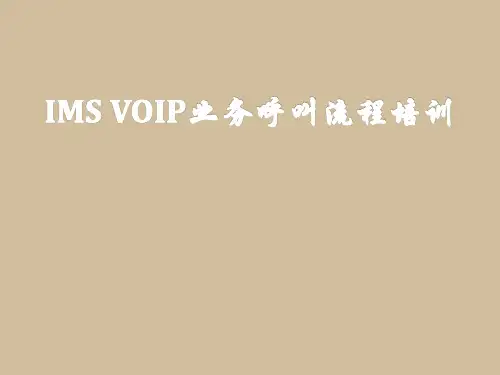
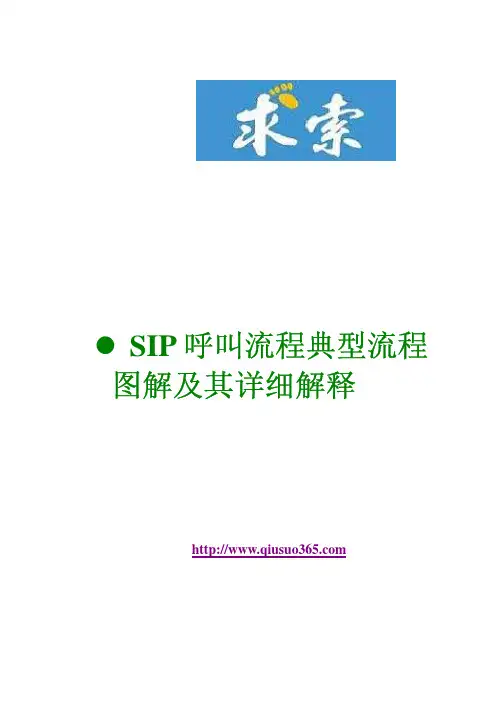
你我 知识分享社区SIP 呼叫流程典型流程 图解及其详细解释目录1.注册流程: ..........................................................................................3 2.注销流程: ..........................................................................................4 3. 基本呼叫建立过程: ........................................................................5 4. 会话更改流程: ................................................................................7 5. 正常呼叫释放过程: ........................................................................8 6. 被叫忙呼叫释放: ............................................................................9 7.被叫无应答流程一: ........................................................................10 8.被叫无应答流程二: ........................................................................11 9.遇忙呼叫前转: ................................................................................12 10.无应答呼叫前转流程: ..................................................................13 11.呼叫保持:.......................................................................................14 12.呼叫等等: ......................................................................................151.注册流程:终端代理A 代理服务器REGISTER (1)401(2)REGISTER(3)200 OK (4)标题(1)用户首次试呼时,终端代理A 向代理服务器发送REGISTER 注册请求; (2)代理服务器通过后端认证/计费中心获知用户信息不在数据库中,便向终端代理回送401 Unauthorized 质询信息,其中包含安全认证所需的令牌; (3)终端代理提示用户输入其标识和密码后,根据安全认证令牌将其加密后,再次用 REGISTER 消息报告给代理服务器; (4)代理服务器将REGISTER 消息中的用户信息解密,通过认证/计费中心验证其合法后, 将该用户信息登记到数据库中,并向终端代理A 返回成功响应消息200 OK。
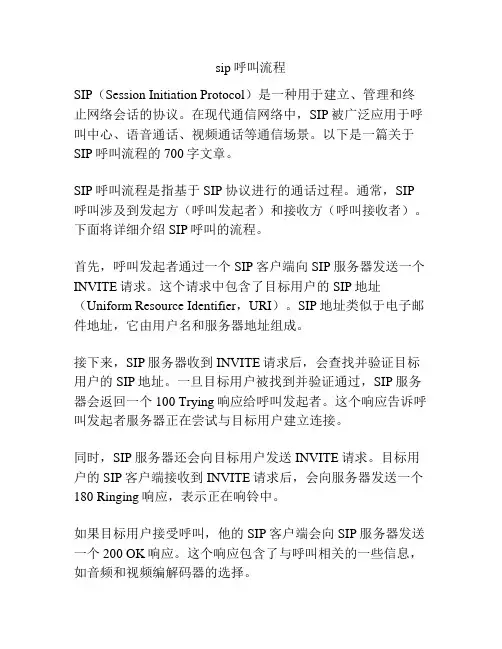
sip呼叫流程SIP(Session Initiation Protocol)是一种用于建立、管理和终止网络会话的协议。
在现代通信网络中,SIP被广泛应用于呼叫中心、语音通话、视频通话等通信场景。
以下是一篇关于SIP呼叫流程的700字文章。
SIP呼叫流程是指基于SIP协议进行的通话过程。
通常,SIP 呼叫涉及到发起方(呼叫发起者)和接收方(呼叫接收者)。
下面将详细介绍SIP呼叫的流程。
首先,呼叫发起者通过一个SIP客户端向SIP服务器发送一个INVITE请求。
这个请求中包含了目标用户的SIP地址(Uniform Resource Identifier,URI)。
SIP地址类似于电子邮件地址,它由用户名和服务器地址组成。
接下来,SIP服务器收到INVITE请求后,会查找并验证目标用户的SIP地址。
一旦目标用户被找到并验证通过,SIP服务器会返回一个100 Trying响应给呼叫发起者。
这个响应告诉呼叫发起者服务器正在尝试与目标用户建立连接。
同时,SIP服务器还会向目标用户发送INVITE请求。
目标用户的SIP客户端接收到INVITE请求后,会向服务器发送一个180 Ringing响应,表示正在响铃中。
如果目标用户接受呼叫,他的SIP客户端会向SIP服务器发送一个200 OK响应。
这个响应包含了与呼叫相关的一些信息,如音频和视频编解码器的选择。
SIP服务器收到200 OK响应后,会将这个响应转发给呼叫发起者的SIP客户端。
同时,服务器还会发送一个ACK请求给目标用户的SIP客户端,表示呼叫已经成功建立。
一旦呼叫建立,呼叫发起者和目标用户之间就可以进行通话了。
他们的语音、视频等数据会通过服务器进行传输。
在这个过程中,SIP客户端可以发送一些其他的SIP消息,如BYE请求,表示结束通话。
当通话结束时,呼叫发起者或目标用户的SIP客户端会发送一个BYE请求给SIP服务器。
服务器收到BYE请求后,会向对方发送一个200 OK响应,表示通话已经结束。
目录2 IMS基本会话流程........................................................... 2-12.1 IMS基本会话流程简介.............................................................. 2-22.2 MO过程........................................................................... 2-32.2.1 主叫IMS SIP用户跨网漫游.................................................... 2-32.2.2 主叫IMS SIP用户在归属域内.................................................. 2-72.3 MT过程........................................................................... 2-82.3.1 被叫IMS SIP用户跨网漫游.................................................... 2-92.3.2 被叫IMS SIP用户在归属域内................................................. 2-122.4 SS过程.......................................................................... 2-132.4.1 主叫和被叫S-CSCF在同一归属域内............................................ 2-142.4.2 主叫和被叫S-CSCF不在同一归属域内.......................................... 2-162.5 IMS会话释放流程................................................................. 2-172.5.1 通话中主叫释放会话......................................................... 2-172.5.2 通话中被叫释放会话......................................................... 2-192.6 媒体协商过程.................................................................... 2-192.6.1 会话建立过程中的协商过程................................................... 2-202.6.2 会话建立后的协商过程....................................................... 2-202.7 资源预留过程.................................................................... 2-212.7.1 主叫侧的资源预留过程....................................................... 2-212.7.2 被叫侧的资源预留过程....................................................... 2-23插图目录图2-1 IMS基本会话流程简图........................................................... 2-2图2-2 主叫IMS SIP用户跨网漫游的MO过程.............................................. 2-4图2-3 主叫IMS SIP用户在归属域内的MO过程............................................ 2-8图2-4 被叫IMS SIP用户跨网漫游的MT过程.............................................. 2-9图2-5 被叫IMS SIP用户在归属域内的MT过程........................................... 2-13图2-6 主、被叫S-CSCF在同一归属域内的SS过程........................................ 2-14图2-7 主、被叫S-CSCF不在同一归属域内的SS过程...................................... 2-17图2-8 通话中主叫释放会话............................................................ 2-18图2-9 通话中被叫释放会话............................................................ 2-19图2-10 主叫侧的资源预留过程......................................................... 2-22图2-11 被叫侧的资源预留过程......................................................... 2-24表格目录表2-1 流程与消息内容详细描述......................................................... 2-4表2-2 流程与消息内容详细描述........................................................ 2-10表2-3 流程与消息内容详细描述........................................................ 2-15表2-4 流程与消息内容详细描述........................................................ 2-18表2-5 流程与消息内容详细描述........................................................ 2-222 IMS基本会话流程关于本章本章描述内容如下表所示。
SIP协议呼叫流程及协议分析SIP(Session Initiation Protocol)是一种用于建立、修改和终止多媒体会话的通信协议。
它在VoIP(Voice over Internet Protocol)和互联网电话系统中被广泛使用。
本文将详细介绍SIP协议的呼叫流程以及对协议的分析。
一、SIP协议呼叫流程1. 注册过程:SIP协议的呼叫流程首先需要进行注册过程。
用户通过SIP客户端向SIP服务器发送注册请求,包含用户的身份信息和位置信息。
SIP服务器将用户信息存储在注册表中,以便后续的呼叫请求。
2. 呼叫建立过程:当用户A想要与用户B进行通话时,需要进行呼叫建立过程。
用户A向SIP服务器发送INVITE请求,指定用户B的地址。
SIP服务器查询注册表,找到用户B的位置信息,并向用户B发送INVITE请求。
用户B接收到INVITE请求后,可以选择接受或拒绝呼叫。
3. 呼叫确认过程:如果用户B接受呼叫,他将向SIP服务器发送200 OK响应。
SIP服务器将200 OK响应转发给用户A。
用户A收到200 OK响应后,也向SIP服务器发送200 OK响应,表示接受呼叫。
4. 媒体协商过程:在呼叫确认后,用户A和用户B需要进行媒体协商过程,以确定通话所使用的编解码器、传输协议等参数。
他们通过交换SDP(Session Description Protocol)信息来完成媒体协商。
5. 媒体传输过程:一旦媒体协商完成,用户A和用户B可以开始进行实际的语音或视频传输。
他们通过RTP(Real-time Transport Protocol)来传输媒体数据。
6. 呼叫结束过程:当通话结束时,用户A或用户B可以发送BYE请求来终止呼叫。
SIP服务器将BYE请求转发给另一方,并向双方发送200 OK响应,表示呼叫已经终止。
二、SIP协议分析1. SIP协议结构:SIP协议由请求和响应组成,每个消息都由起始行、头部和消息体组成。
SIP协议呼叫流程及协议分析SIP(Session Initiation Protocol)是一种用于建立、修改和终止多媒体会话的协议。
它被广泛应用于VoIP(Voice over Internet Protocol)和实时通信系统中。
本文将详细介绍SIP协议的呼叫流程,并进行协议分析。
一、SIP协议呼叫流程SIP协议呼叫流程主要包括注册、呼叫建立、媒体协商和呼叫结束四个阶段。
1. 注册阶段在SIP系统中,用户需要先进行注册,以便系统能够识别并定位用户。
注册阶段的流程如下:- 用户向SIP服务器发送一个REGISTER请求,请求中包含用户的身份信息。
- SIP服务器接收到REGISTER请求后,验证用户身份,并将用户信息存储在注册表中。
- SIP服务器返回200 OK响应,表示注册成功。
2. 呼叫建立阶段一旦用户完成注册,就可以进行呼叫建立。
呼叫建立阶段的流程如下:- 主叫用户向SIP服务器发送INVITE请求,请求中包含被叫用户的SIP地址。
- SIP服务器根据被叫用户的SIP地址查询注册表,获取被叫用户的位置信息,并将INVITE请求转发给被叫用户所在的终端。
- 被叫用户的终端接收到INVITE请求后,向SIP服务器发送100 Trying响应,表示正在处理请求。
- 被叫用户的终端根据INVITE请求中的媒体描述信息,与主叫用户的终端进行媒体协商。
- 被叫用户的终端向SIP服务器发送180 Ringing响应,表示正在振铃。
- 被叫用户的终端与主叫用户的终端建立媒体通道后,向SIP服务器发送200 OK响应,表示呼叫建立成功。
3. 媒体协商阶段在呼叫建立成功后,主叫用户和被叫用户之间需要进行媒体协商,以确定音视频等媒体流的传输方式和参数。
媒体协商阶段的流程如下:- 主叫用户的终端向被叫用户的终端发送媒体描述信息,包含音视频编码格式、传输协议等。
- 被叫用户的终端根据媒体描述信息,选择合适的编码格式和传输协议,并向主叫用户的终端发送媒体描述信息。
IMS主要协议和典型流程
SIP是一种应用层协议,用于建立、修改和断开多媒体会话,它是
IMS中最核心的协议之一、其典型的流程包括:
1. 注册流程:用户在终端设备上输入自己的账号和密码,终端设备
通过SIP协议向Home Subscriber Server(HSS)发送注册请求,HSS验
证用户的身份,并返回注册成功的消息给用户终端设备。
2. 会话建立流程:用户A通过终端设备向用户B发送一个通话请求,用户B通过终端设备接收到请求后,可以选择接受或者拒绝。
如果用户B
接受请求,B的终端设备通过SIP协议向B的Proxy-Call Session
Control Function(P-CSCF)发送一个呼叫请求,P-CSCF根据B的位置
信息在服务域内查找用户B对应的S-CSCF,S-CSCF负责处理B的呼叫请求,最终将请求发送给B。
3.呼叫传输流程:一旦用户B接受请求,通话的数据就可以通过SIP
协议进行传输。
通话数据经过用户终端设备、P-CSCF、S-CSCF等网络设备,最终到达用户的终端设备。
在通话过程中,用户可以进行多种操作,
如静音、挂断等。
4.会话结束流程:一方挂断通话后,终端设备通过SIP协议向对方发
送一个结束通话的消息,对方通过终端设备接收到消息后,也会发送一个
结束通话的消息给对方。
双方的终端设备接收到对方的结束通话消息后,
会结束通话。
总的来说,IMS的主要协议是SIP,它通过注册、会话建立、呼叫传
输和会话结束等流程实现多媒体通信。
通过IMS,用户可以使用终端设备
进行语音、视频、数据等多种类型的通信,实现了多媒体通信的统一和标准化。
SIP基本呼叫流程SIP(Session Initiation Protocol)是一种基于IP网络的信令协议,用于建立、修改和终止多媒体会话,包括语音、视频和即时通讯等。
下面将详细介绍SIP的基本呼叫流程。
SIP的基本呼叫流程如下:1. 注册:首先,用户需要向SIP服务器注册自己的地址信息。
用户的地址信息包括SIP URI(Uniform Resource Identifier)、用户名、密码等。
注册操作是SIP协议中的一个非必需步骤,是为了能够将用户的地址信息与用户的通信设备进行绑定,方便其他用户能够找到用户并进行通信。
3. 定位:SIP服务器接收到呼叫请求后,需要对目的地址进行定位。
定位的目的是找到目的用户所在的网络和设备,以便向其发送呼叫请求。
定位的过程可以通过DNS(Domain Name System)解析等方式进行。
4.会话建立:一旦SIP服务器找到了目的用户,它将会话建立请求发送给目的用户所在的设备。
目的设备收到建立请求后,如果接受呼叫,则向SIP服务器发送会话建立响应。
5.会话描述:在会话建立响应中,目的设备可以附带一个会话描述文件,该文件用于描述会话的具体规格,包括媒体类型(音频、视频等),编码方式等。
6.会话修改:在会话描述中,如果需要对会话规格进行修改,可以发送会话修改请求,并在会话修改响应中附带修改后的会话描述文件。
会话修改可以用于增加或删除会话中的媒体流,改变编码方式等。
8.会话终止:当用户希望结束会话时,可以发送会话终止请求。
会话终止请求会通过SIP服务器传递给目的设备,目的设备收到请求后会向SIP服务器发送会话终止响应。
9.会话释放:一旦SIP服务器收到会话终止响应,它将释放会话资源,并向呼叫发起方发送一个会话释放响应。
以上就是SIP基本呼叫流程的详细介绍。
SIP常被用于VoIP(Voice over IP)等应用中,可以实现语音呼叫、视频通话、即时消息等功能。
通过理解SIP的基本呼叫流程,可以更好地理解和使用SIP协议。
ims呼叫流程IMS呼叫流程。
IMS(IP Multimedia Subsystem)是一种基于IP网络的多媒体通信系统,它为多种服务提供了统一的访问和交付平台。
在IMS中,呼叫流程是非常重要的一部分,它涉及到用户与网络之间的交互,以及网络内部各个功能模块之间的通信。
下面将详细介绍IMS呼叫流程的相关内容。
首先,当用户发起呼叫时,终端设备会向IMS网络发送呼叫请求。
这个呼叫请求会经过无线接入网和核心网,最终到达IMS核心网络。
在核心网中,呼叫请求会被路由到相应的呼叫控制功能(Call Session Control Function,CSCF)节点上。
接下来,CSCF节点会对呼叫请求进行处理,包括鉴权、用户状态查询等操作。
如果用户合法且可用,CSCF节点会向用户发送呼叫响应,表示呼叫请求已经被接受。
同时,CSCF节点会向相应的应用服务器发送呼叫请求,以便应用服务器进行呼叫处理。
在得到应用服务器的处理结果后,CSCF节点会向用户发送呼叫响应,告知用户呼叫处理的结果。
如果呼叫成功,用户可以与被叫用户进行通话;如果呼叫失败,用户会收到相应的失败提示。
在通话过程中,IMS网络会对通话进行监控和管理,以保证通话质量和用户体验。
一旦通话结束,终端设备会向IMS网络发送通话释放请求,IMS网络会对通话进行清理和释放。
除了上述的基本呼叫流程外,IMS还支持一些高级的呼叫功能,比如呼叫转移、呼叫等待、多方通话等。
这些功能都是基于IMS网络的强大能力和灵活性而实现的,为用户提供了丰富多彩的通信体验。
总的来说,IMS呼叫流程是一个复杂而又精密的系统工程,它涉及到多个网络节点和功能模块之间的协作与交互。
通过上述的介绍,相信大家对IMS呼叫流程有了更深入的了解。
希望本文能够帮助大家更好地理解IMS网络,并为相关领域的研究和实践提供一定的参考价值。
3GPP2 X.S0013-009-0Version: 1.0Date: December 2007IMS/MMD Call Flow ExamplesCOPYRIGHT3GPP2 and its Organizational Partners claim copyright in this document and individual Organizational Partners may copyright and issue documents or standards publications in individual Organizational Partner’s name based on this document. Requests for reproduction of this document should be directed to the 3GPP2 Secretariat at secretariat@. Requests to reproduce individual Organizational Partner’s documents should be directed to that Organizational Partner. See for more information.X.S0013-009-0 v1.0 IMS/MMD Call Flow Examples Revision HistoryRevision Changes Date v1.0 Initial Publication December, 2007IMS/MMD Call Flow Examples1CONTENTS23Revision History ii 41Introduction 4 2Glossary and Definitions 5 562.1Acronyms 5 72.2Definitions 53References 6 893.1Normative References 6 103.2Informative References 64Methodology 711124.1Functional Entities covered by call flows 7 134.2Identities 7 144.2.1User and Network Identities (7)154.3Notation for call flows 8 165Registration Procedures 8 6Signaling flows for session establishment 917186.1General assumptions 9 196.2Scenarios 96.2.1Scenario 1 (9)20216.2.1.1Assumptions (10)226.2.1.2Call Flow (10)6.2.2Scenario 2 (15)236.2.2.1Assumptions (15)246.2.2.2Call Flow (15)256.2.3Scenario 3 (16)266.2.3.1Assumptions (16)27286.2.3.2Call flow (16)296.2.4Scenario 4 (23)306.2.4.1Assumptions (23)316.2.4.2Call flow (23)32Appendix A (Informative): VoIP example with QoS reservation, activation, and updating at RAN 31A.1QoS Configuration for VoIP in advance 3133A.2Resource activation on originating side 3334A.3Resource activation on terminating side 34351A.4Updating of resource reservation 35 2A.4.1Resource updating on originating side 35A.4.2Resource updating on terminating side 37 34LIST OF FIGURES1Figure 1 Originating UE resource ready, terminating UE resource ready (10)23Figure 2 Originating UE resource ready, terminating UE resource not ready (15)4Figure 3 Originating UE not ready, Terminating UE ready (17)5Figure 4 Originating UE not ready, Terminating UE not ready (24)6Figure 5 QoS configuration for VoIP (32)Figure 6 QoS Activation on Originating UE (33)78Figure 7 QoS Activation on Terminating UE (34)9Figure 8 Resource Updating on Originating UE (36)Figure 9 Resource Updating on Terminating UE (37)10111 Introduction12The document provides examples of signaling flows for the IP multimedia call control based on 3SIP and SDP. The signaling flows specified in this document are only for informational purposes.If there is ambiguity between this specification and [1], the text specified in [1] shall be followed. 45The call flows describe the behavior of the mobile stations under various conditions for setting up 6real time services like VoIP and PSVT.7In this document, several key words are used to signify the requirements. The key words “shall”, 8“shall not”, “should”, “should not” and “may” are to be interpreted as described in [6] and the TIA 9Engineering Style Manual.X.S0013-009-0 v1.0 IMS/MMD Call Flow Examples2 Glossary and Definitions12.1 Acronyms2 AAA Authentication, Authorization, and Accounting3AN Access Network 4 AT Access Terminal 5 EMPA Enhanced Multi-Flow Packet Application 6 HRPD High Rate Packet Data 7 HSS Home Subscriber Server 8 IMS IP Multimedia Subsystem9 IP Internet Protocol 10 IP-CAN IP-Connectivity Access Network 11 MMD Multi Media Domain 12 MPA Multi-Flow Packet Application 13 PDSN Packet Data Serving Node 14 PFO PPP Free Operation 15 PPP Point to Point Protocol 16 PSVT Packet Switched Video Telephony 17 QoS Quality of Service 18 RAN Radio Access Network19 RSVP Resource ReSerVation Protocol 20 SBBC Service Based Bearer Control 21 SDP Session Description Protocol 22 SIP Session Initiation Protocol 23 TFT Traffic Flow Template 24 UDP User Datagram Protocol 25 UE User Equipment 26 VoIP Voice Over IP27 2.2 Definitions28 CallerThe person placing a call29 Called party The recipient or destination of a call30 AlertThe audible notification given to the Called party of an incoming call. 31 Ring BackThe audible notification given to a Caller to indicate that the Called 32 party has been located and is being alerted333 References12The following documents contain provisions, which, through reference in this text, constitute 3provisions of this document.4References are either specific (identified by date of publication, edition number, version 5number, etc.) or non-specific.6For a specific reference, subsequent revisions do not apply.7For a non-specific reference, the latest version applies. In the case of a reference to a 83GPP2 document, a non-specific reference implicitly refers to the latest version of that 9document in the same Release as the present document.References3.1 Normative1011[1]3GPP2 X.S0013-004-A v1.0: “IP Multimedia Call Control Protocol Based on SIP and SDP 12Stage 3”.13[2]3GPP2 X.S0013-002-A v1.0: “IP Multimedia (IM) Subsystem – Stage 2”.14[3]IETF RFC 2429, “ RTP Payload Format for the 1998 Version of ITU-T Rec. H.263 Video15(H.263+)”.16[4]IETF RFC 3558, “RTP Payload Format for Enhanced Variable Rate Codecs (EVRC) and 17Selectable Mode Vocoders (SMV)”.18[5]IETF RFC 3262, “Reliability of provisional Responses in the Session Initiation Protocol(SIP)”1920[6]IETF RFC 2119, “Key words for use in RFCs to Indicate Requirement Levels”, March 1997.21[7]3GPP2 X.S0013-005-A v1.0: “All-IP Core Network Multimedia Domain IP Multimedia 22Subsystem Cx Interface Signaling flows and Message Contents” – Annex A.23References3.2 Informative242526[8] 3GPP2 X.S0013-012-0 v1.0: “All-IP Core Network Multimedia Domain; Service Based 27Bearer Control – Stage 2”.28X.S0013-009-0 v1.0 IMS/MMD Call Flow Examples4 Methodology14.1 Functional Entities covered by call flows23The flows show the signaling exchanges between the following functional entities:45User Equipment (UE)6Proxy-CSCF (P-CSCF)7Interrogating-CSCF (I-CSCF)8Serving-CSCF (S-CSCF)910The call flows mainly show the interactions between the UE-1 and UE-2 for call origination and 11termination. The procedures and the message exchanged between these elements are as described in [1].124.2 Identities134.2.1 User and Network Identities1415The public identity of UE-1 is sip:UE-1@. The public identity of UE-2 issip:UE-2@161718The following are network entities associated with UE-1:1920Home Domain of UE-1: 21P-CSCF serving UE-1: 22I-CSCF serving UE-1: 23S-CSCF serving UE-1: 24The following are the network entities associated with UE-2:2526Home Domain of UE-2: 27P-CSCF serving UE-2: 28I-CSCF serving UE-2: 29S-CSCF serving UE-2: 3031In the example session establishment flows, both UE-1 and UE-2 are assumed to be in the home 32network. So, the P-CSCF1 and P-CSCF2 are in UE-1’s and UE-2’s respective home networks.33However, according to [2], the P-CSCF can be either in the home or visited network. The session 34establishment call flows described in this document are not affected whether the P-CSCF is in the 35visited or home network.36For brevity, I-CSCF and S-CSCF are shown together in the session establishment call flows.4.3 Notation for call flows12Offer/Answer exchange process is also shown in the call flows. For brevity, the following notation is used to 3represent offer and answer:4•“O” and “A” in the call flows represent “Offer” and “Answer”.5•“O n” represents the n th SDP offer. For example, if there are two offer/answer exchanges during the call 6setup process, then the first offer will be noted as “O1” and the second as “O2”.7•“A n” represents the n th SDP Answer. Answer “A n” corresponds to Offer “O n”.891011Procedures5 Registration1213The registration procedures for UE-1 and UE-2 are as specified in [1] and [7]. UE-1 registers with 14S-CSCF1 through P-CSCF1 and UE-2 registers with S-CSCF2 through P-CSCF2.1516171 6 Signaling flows for session establishment2 In all of the call flows provided in this document, registration procedures are assumed to have already been3 completed. 45 6.1 General assumptions6All the call flows shown in this document assume the following:7 • The originating UE and the terminating UE both support precondition and reliable provisional responses8 100 (rel).9 • The originating UE will only include “Supported: precondition” in the SIP INVITE it sends out to its peer.10 o If the originating UE wishes to both send and receive media with its peer, and the resources are11 reserved for the stream, the originating UE marks the stream as sendrecv using the “a=sendrecv” 12 attribute. (Note: for sendonly streams, the originating UE marks the stream as “a=sendonly” and 13 for recvonly streams, the originating UE marks the stream as “a=recvonly”).14 o If the originating UE wishes to communicate with its peer, and the resources are not reserved for15 the stream, the originating UE marks the particular stream as inactive using the “a=inactive” 16 attribute.17 • If the “Supported” header in the incoming INVITE includes “precondition” and the terminating UE decides18 to use precondition, the terminating UE includes “Require: precondition” in all reliable responses that carry 19 SDP (i.e., offer or answer).20 • The terminating UE sends 180 (Ringing) response reliably. Note that sending the 180 (Ringing) response21 reliably does not increase the call setup time experienced by the caller.22 • If the 180 (Ringing) response contains an answer (or offer), the called party is alerted only after receiving a23 PRACK request for the 180 (Ringing) response. This enhances the caller/called party user experience. For 24 example, if the called party picks up the phone before the 180 (Ringing) response reaches the caller, the 25 caller will only be able to hear the called party but will not be able to respond,26 • Both UEs have the required resources ready before the terminating UE can alert the called party of an27 incoming call.28 • For brevity, 100 (Trying) messages are not shown in the figures. 29 • The SBBC interactions [8] are not shown in the call flows. 3031 6.2 Scenarios32 The following scenarios are considered for the session establishment process:33 • Scenario 1: Originating UE has resources ready before sending INVITE, terminating UE has resources34 ready before sending the first provisional response;35 • Scenario 2: Originating UE has resources ready before sending INVITE, terminating UE does not have36 resources ready before sending the first provisional response;37 • Scenario 3: Originating UE does not have resources ready before sending INVITE, terminating UE has38 resources ready before sending the first provisional response;39 • Scenario 4: Originating UE does not have resources ready before sending INVITE, terminating UE does40 not have resources ready before sending the first provisional response.4142 The call flows for the above four scenarios are depicted in the subsequent subsections.43 6.2.1 Scenario 144 This section covers the scenario where the originating UE’s resources are ready before sending INVITE, and the45terminating UE’s resources are ready before sending the first provisional response.126.2.1.1 Assumptions3Flow6.2.1.2 Call45The following section applies to the case where UE-1 has its resource ready before sending the6INVITE request to UE-2. The terminating UE, UE-2, also has its resource ready before answering theINVITE request with the first provisional response.789Note: This flow assumes UE-2 has sufficient resources available prior to receiving the INVITE.101112Figure 1 Originating UE resource ready, terminating UE resource ready131. INVITE (UE-1 to P-CSCF1)1415UE-1 determines the set of codecs or media streams that it wishes to support for the session. It builds an SDP offer16containing characteristics of each codec, and assigns local port numbers for each possible media flow. Multiple media flows may be offered, and for each media flow (m= line in SDP), there may be multiple codec choices 1718offered.19For this example, it is assumed that UE-1 is willing to establish a multimedia session comprising a video stream and2021an audio stream. The video stream supports one H.263 codec as specified in [3]. The audio stream supports both22EVRC and SMV codecs as specified in [4].2324In addition, UE-1 indicates that precondition is supported for this session. In the SDP offer, it indicates that resource25is already available at the local end point.Table 6.2.1.2-1 INVITE (UE-1 to P-CSCF1)1INVITE sip:UE-2@ SIP/2.0From: <sip:UE-1@>;tag=169f498-0-13c4-78e-2044f20e-78eTo: <sip:UE-2@>Call-ID: 16a1b80-0-13c4-78e-6a540802-78e@10.20.1.100CSeq: 1 INVITEVia: SIP/2.0/UDP 10.20.1.100:1357;comp=sigcomp;branch=z9hG4bK-78f-1d86b6-24d29348Max-Forwards: 70Route: <sip::7531;lr;comp=sigcomp>, <sip:;lr>P-Preferred-Identity: "User-1" <sip:UE-1@>P-Access-Network-Info: 3GPP2-1X-HRPD; ci-3gpp2=1234123412341234123412341234123411Privacy: noneRequire: sec-agreeProxy-Require: sec-agreeSecurity-Verify: ipsec-3gpp; q=0.1; alg=hmac-sha-1-96;spi-c=98765432; spi-s=76543210;port-c=13579; port-s=23456Contact: <sip:UE-1@10.20.1.100:1357;comp=sigcomp>Allow: INVITE, ACK, CANCEL, BYE, PRACK, UPDATE, REFER, MESSAGESupported: 100rel, preconditionContent-Type: application/sdpContent-Length: xxxv=0o=- 3323527065117000 3323527065117000 IN IP4 10.20.1.100s=-c=IN IP4 10.20.1.100t=0 0m=audio 49500 RTP/AVP 97 99b=AS:25.4a=curr:qos local sendrecva=curr:qos remote nonea=des:qos optional local sendrecva=des:qos optional remote sendrecva=rtpmap:97 EVRC/8000a=ptime:20a=rtpmap:99 SMV/8000m=video 49600 RTP/AVP 34b=AS:75a=curr:qos local sendrecva=curr:qos remote nonea=des:qos optional local sendrecva=des:qos optional remote sendrecva=rtpmap:34 H263/90000a=cif:1232. INVITE (P-CSCF1 to I/S-CSCF1)4The P-CSCF1 adds itself to the Record-Route header and Via header. As the request is forwarded to an interface that 5is not compressed, the P-CSCF1 SIP URI does not contain the "comp=sigcomp" parameter. The P-CSCF1 removes 6the Security-Verify header and associated "sec-agree" option-tags prior to forwarding the request. As the Require 7and Proxy-Require headers are empty, P-CSCF1 removes those headers completely.8The INVITE request is forwarded to the I/S-CSCF1.910113. INVITE (I/S-CSCF1 to I/S-CSCF2)12S-CSCF1 performs an analysis of the destination address, and determines the network operator to whom the 13destination subscriber belongs. Since the originating operator does not desire to keep their internal configuration 14hidden, S-CSCF1 forwards the INVITE request directly to I-CSCF2 in the destination network.1516The I-CSCF2 sends a query to the HSS to find out the S-CSCF2 of the called user. The HSS responds with the1address of the current S-CSCF2 for the terminating subscriber. I-CSCF2 forwards the INVITE request to the2S-CSCF2 that will handle the session termination. S-CSCF2 validates the service profile of this subscriber and3evaluates the initial filter criteria.454-5. INVITE (I/S-CSCF2 to UE-2)S-CSCF2 forwards the INVITE request to UE-2 via P-CSCF2.6786. 180 Ringing (UE-2 to P-CSCF2)9UE-2 has accepted both video and audio streams, and EVRC is the chosen codec for the audio stream. Since10resources are already available for UE-2, it sends a 180 (Ringing) response reliably with the SDP answer indicating11that resources are reserved at both endpoints.127-10. 180 Ringing (P-CSCF2 to UE-1)1314P-CSCF2 forwards the 180 (Ringing) response to UE-1 via I/S-CSCF2, I/S-CSCF1, and P-CSCF1. Table 6.2.1.2-215shows the 180 (Ringing) response in detail.1617Table 6.2.1.2-2 180 Ringing (P-CSCF1 to UE-1)SIP/2.0 180 RingingFrom: <sip:UE-1@>;tag=169f498-0-13c4-78e-2044f20e-78eTo: <sip:UE-2@>;tag=169f7f8-0-13c4-9f6-33835972-9f6Call-ID: 16a1b80-0-13c4-78e-6a540802-78e@10.20.1.100CSeq: 1 INVITEVia: SIP/2.0/UDP 10.20.1.100:1357;comp=sigcomp;branch=z9hG4bK-78f-1d86b6-24d29348Record-Route:<sip:;lr>,<sip:;lr>,<sip:;lr>, <sip::7531;lr;comp=sigcomp>Contact: <sip:UE-2@10.30.1.24:8805;comp=sigcomp>P-Asserted-Identity: "User 2" <sip:UE-2@>, <tel:+1-858-335-7341>Privacy: noneAllow: INVITE, ACK, CANCEL, BYE, PRACK, UPDATE, REFER, MESSAGERequire: 100rel, preconditionRSeq: 1000Content-Type: application/sdpContent-Length: xxxv=0o=- 33235270718000 33235270718000 IN IP4 10.30.1.24s=-c=IN IP4 10.30.1.24t=0 0m=audio 49700 RTP/AVP 97a=curr:qos local sendrecva=curr:qos remote sendrecva=des:qos optional local sendrecva=des:qos optional remote sendrecva=rtpmap:97 EVRC/8000a=ptime:20m=video 49702 RTP/AVP 34a=curr:qos local sendrecva=curr:qos remote sendrecva=des:qos optional local sendrecva=des:qos optional remote sendrecva=rtpmap:34 H263/90000a=cif:118192011. PRACK (UE-1 to P-CSCF1)21UE-1 acknowledges the 180 (Ringing) response from UE-2 with a PRACK request as specified in [5]. (Table6.2.1.2-3)2223If UE-1 determines to make any change in media flows, it includes a new SDP offer in the PRACK request sent to 12UE-2. Otherwise, no SDP offer is included in the PRACK request.3Table 6.2.1.2-3 PRACK (UE-1 to P-CSCF1)4PRACK sip:UE-2@10.30.1.24:8805;comp=sigcomp SIP/2.0From: <sip:UE-1@>;tag=169f498-0-13c4-78e-2044f20e-78eTo: <sip:UE-2@>; tag=169f7f8-0-13c4-9f6-33835972-9f6Call-ID: 16a1b80-0-13c4-78e-6a540802-78e@10.20.1.100P-Access-Network-Info: 3GPP2-1X-HRPD;ci-3gpp2=1234123412341234123412341234123411CSeq: 2 PRACKVia: SIP/2.0/UDP 10.20.1.100:1357;comp=sigcomp;branch=z9hG4bK-78f-1d86b6-24d29348Max-Forwards: 70Route:<sip::7531;lr;comp=sigcomp>,<sip:;lr>,<sip:scscf2.d ;lr>,<sip:;lr>RAck: 1000 1 INVITEContent-Length: 05612. PRACK (P-CSCF1 to I/S-CSCF1)7The P-CSCF forwards the PRACK request to S-CSCF. As the Proxy-Require header is empty, the P-CSCF removes this header completely.891013-14. PRACK (I/S-CSCF1 to P-CSCF2)The I/S-CSCF1 forwards the PRACK request to P-CSCF2 via I/S-CSCF2.11121315. PRACK (P-CSCF2 to UE-2)UE-2 starts alerting the user after it receives the PRACK request for the 180 (Ringing) response. UE-2 may also1415alert the user before receiving the PRACK request, but there may be media clipping if the user answers the call before the 180 (Ringing) response reaches UE-1.16171816. 200 OK (UE-2 to P-CSCF2)19The 200 OK response is generated by UE-2 to acknowledge the reception of the PRACK request.202117-20. 200 OK (P-CSCF2 to UE-1)22The P-CSCF2 forwards the 200 OK response to UE-1 via I/S-CSCF2, I/S-CSCF1, and P-CSCF1. Table 6.2.1.2-4 23shows the 200 OK message going from P-CSCF1 to UE-1.2425Table 6.2.1.2-4 200 OK (P-CSCF1 to UE-1)SIP/2.0 200 OKFrom: <sip:UE-1@>;tag=169f498-0-13c4-78e-2044f20e-78eTo: <sip:UE-2@>;tag=169f7f8-0-13c4-9f6-33835972-9f6Call-ID: 16a1b80-0-13c4-78e-6a540802-78e@10.20.1.100CSeq: 2 PRACKVia: SIP/2.0/UDP 10.20.1.100:1357;comp=sigcomp;branch=z9hG4bK-78f-1d86b6-24d29348Content-Length: 0262721. 200 OK (UE-2 to P-CSCF2)28When the user at UE-2 answers the call, UE-2 generates a 200 OK response towards UE-1 to answer the INVITE 29request.303122-25. 200 OK (P-CSCF2 to UE-1)The P-CSCF2 forwards the 200 OK response to UE-1 via I/S-CSCF2, I/SCSCF1, and P-CSCF1. Table 6.2.1.2-53233shows the 200 OK message going from P-CSCF1 to UE-1.Table 6.2.1.2-5 200 OK (P-CSCF1 to UE-1)1 SIP/2.0 200 OKFrom: <sip:UE-1@>;tag=169f498-0-13c4-78e-2044f20e-78e To: <sip:UE-2@>;tag=169f7f8-0-13c4-9f6-33835972-9f6 Call-ID: 16a1b80-0-13c4-78e-6a540802-78e@10.20.1.100 CSeq: 1 INVITERecord-Route:<sip:;lr>,<sip:;lr>,<sip:;lr>,<sip::7531;lr;comp=sigcomp>Via: SIP/2.0/UDP 10.20.1.100:1357;comp=sigcomp;branch=z9hG4bK-78f-1d86b6-24d29348 Contact: <sip:UE-2@10.30.1.24:8805;comp=sigcomp> Content-Length: 02 26. ACK (UE-1 to P-CSCF1)3 UE responds to the 200 OK with an ACK request sent to P-CSCF1. (Table 6.2.1.2-6).4 Table 6.2.1.2-6 ACK (UE-1 to P-CSCF1)567 27-30. ACK (P-CSCF1 to UE-2)8 The P-CSCF1 forwards the ACK response to UE-2 via I/S-CSCF1, I/S-CSCF2, and P-CSCF2.9 ACK sip:UE-2@10.30.1.24:8805;comp=sigcomp SIP/2.0From: <sip:UE-1@>;tag=169f498-0-13c4-78e-2044f20e-78e To: <sip:UE-2@>;tag=169f7f8-0-13c4-9f6-33835972-9f6 Call-ID: 16a1b80-0-13c4-78e-6a540802-78e@10.20.1.100 CSeq: 1 ACKVia: SIP/2.0/UDP 10.20.1.100:5060;comp=sigcomp;branch=z9hG4bK-792-1d9290-49ff0c31 Max-Forwards: 70Route: <sip::7531;lr;comp=sigcomp>,<sip:;lr>, <sip:;lr>, <sip:;lr> Content-Length: 0126.2.2 Scenario23This section covers the scenario where the originating UE’s resources are ready before sending INVITE, and the 4terminating UE’s resources are not ready before sending the first provisional response566.2.2.1 Assumptions7Flow6.2.2.2 Call89This scenario assumes that the terminating UE, UE-2, does not have the resource ready before sending the first 10provisional response. UE-2 may send a 183 (Session Progress) response unreliably. At the same time, UE-2 also 11starts the resource reservation process. Once the resource is ready at UE-2 side, the UE-2 sends 180 (Ringing) 12response reliably to UE-1, including an SDP answer to indicate that the resource is ready. The SDP offer/answer 13exchanges are the same as those in Scenario 1.1415Figure 2 Originating UE resource ready, terminating UE resource not ready16136.2.3 Scenario23This section covers the scenario where the originating UE’s resources are not ready before sending INVITE, and 4terminating UE’s resources are ready before sending the first provisional response.56.2.3.1 Assumptions6The call flow in this section assumes that the originating UE, UE-1, has resources ready before sending the PRACK 7request to the first provisional response. In case UE-1’s resources are not ready before sending the PRACK request 8for the first provisional response (183), then UE-1 needs to send an UPDATE request to UE-2 to indicate that 9resources are ready, after the resource reservation is completed.10flow6.2.3.2 Call1112The following section applies to the case where UE-1 has no resource reserved before sending the initial INVITE 13request to UE-2.141512Figure 3 Originating UE not ready, Terminating UE ready31-5. INVITE (UE-1 to P-CSCF1)45UE-1 determines the set of codecs or media streams that it wishes to support for the session. It builds a SDPcontaining characteristics of each codec, and assigns local port numbers for each possible media flow. Multiple 67media flows may be offered, and for each media flow (m= line in SDP), there may be multiple codec choices8offered.9For this example, it is assumed that UE-1 desires to establish a multimedia session comprising a video stream and an1011audio stream. The video stream supports one H.263 codec. The audio stream supports both EVRC and SMV codec.1213UE-1 does not indicate that precondition is required for this session, but indicates that it is supported. (This approachoptimizes compatibility and performance when interworking with 3rd party (non-MMD) terminals). In the SDP body,1415UE-1 indicates the current resource status and that the desired resource status is optional. UE-1 also sets every media stream to inactive mode by using the ‘a=inactive’ SDP attribute in the SDP offer. Detecting the QoS precondition 16content in the SDP, UE-2 indicates resource reservation, but the session can continue regardless of whether or not 17this reservation is possible.1819UE-1 does not indicate that reliable provisional responses are required, but indicates that they are supported. This2021gives UE-2 the ability to reliably send only those responses that are most appropriate.12Table 6.2.3.2-7 INVITE (UE-1 to P-CSCF1)INVITE sip:UE-2@ SIP/2.0Via: SIP/2.0/UDP 100.200.1.1:1357;comp=sigcomp;branch=z9hG4bK4d29348From: <sip:UE-1@>;tag=a48sTo: <sip:UE-2@>Call-ID: f81d4fae-7dec-11d0-a765-00a0c91e6bf6@CSeq: 1 INVITEMax-Forwards: 70Route: <sip::7531;lr;comp=sigcomp>, <sip:;lr>P-Preferred-Identity: "User-1" <sip:UE-1@>P-Access-Network-Info: 3GPP2-1X-HRPD; ci-3gpp2=1234123412341234123412341234123411Privacy: noneContact: <sip:UE-1@100.200.1.1:1357;comp=sigcomp>Allow: INVITE, ACK, CANCEL, BYE, PRACK, UPDATE, REFER, MESSAGERequire: sec-agreeProxy-Require: sec-agreeSupported: 100rel, preconditionSecurity-Verify: ipsec-3gpp; q=0.1; alg=hmac-sha-1-96; spi-c=9876543; spi-s=3456789;port-c=8642; port-s=7531Content-Type: application/sdpContent-Length: xxxv=0o=- 2987935614 2987935614 IN IP4 100.200.1.1s=-c=IN IP4 100.200.1.1t=0 0m=audio 10500 RTP/AVP 97 99b=AS:25.4a=inactivea=curr:qos local nonea=curr:qos remote nonea=des:qos optional local sendrecva=des:qos optional remote sendrecva=rtpmap:97 EVRC/8000a=ptime:20a=rtpmap:99 SMV/8000m=video 10600 RTP/AVP 34b=AS:75a=inactivea=curr:qos local nonea=curr:qos remote nonea=des:qos optional local sendrecva=des:qos optional remote sendrecva=rtpmap:34 H263/90000a=cif:1346-10. 183 (P-CSCF1 to UE-1)5UE-2 accepts both video and audio streams, and chooses EVRC as the codec for the audio stream. An SDP answer is 6included to assist UE-1 in completing resource reservation as early as possible. The SDP answer includes precondition status.781Table 6.2.3.2-8 183 Session Progress (P-CSCF1 to UE-1)SIP/2.0 183 Session ProgressVia: SIP/2.0/UDP 100.200.1.1:1357;comp=sigcomp;branch= z9hG4bK4d29348From: <sip:UE-1@>;tag=a48sTo: <sip:UE-2@>;tag=a9f6Call-ID: f81d4fae-7dec-11d0-a765-00a0c91e6bf6@CSeq: 1 INVITERecord-Route:<sip:;lr>,<sip:;lr>,<sip:;lr>,<sip::7531;lr;comp=sigcomp>Contact: <sip:UE-2@100.300.1.2:2345;comp=sigcomp>P-Asserted-Identity: "User 2" <sip:UE-2@>, <tel:+1-972-321-9876>Privacy: noneAllow: INVITE, ACK, CANCEL, BYE, PRACK, UPDATE, REFER, MESSAGERequire: 100rel, preconditionRSeq: 1000Content-Type: application/sdpContent-Length: xxxv=0o=- 35270718123 35270718123 IN IP4 100.300.1.2s=-c=IN IP4 100.300.1.2t=0 0m=audio 10700 RTP/AVP 97b=AS:25.4a=inactivea=curr:qos local sendrecva=curr:qos remote nonea=des:qos optional local sendrecva=des:qos optional remote sendrecva=conf:qos remote sendrecva=rtpmap:97 EVRC/8000a=ptime:20m=video 10702 RTP/AVP 34b=AS:75a=inactivea=curr:qos local sendrecva=curr:qos remote nonea=des:qos optional local sendrecva=des:qos optional remote sendrecva=conf:qos remote sendrecva=rtpmap:34 H263/90000a=cif:12311-15. PRACK (UE-1 to P-CSCF1)4UE-1 acknowledges the 183 (Session Progress) response from UE-2 with a PRACK request. Resource reservation at 5UE-1 is assumed to have been completed at some point prior to sending the PRACK request. The local resource 6status is included in the SDP offer.78。